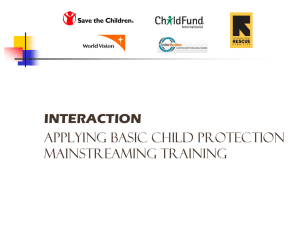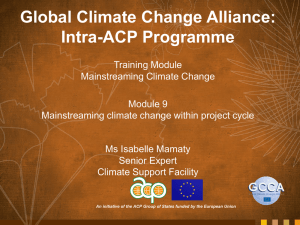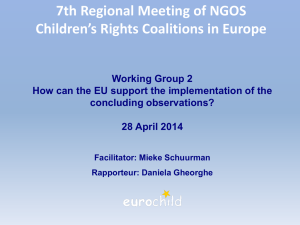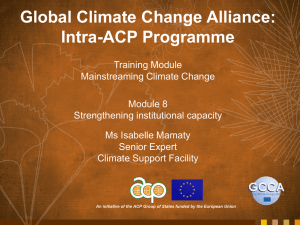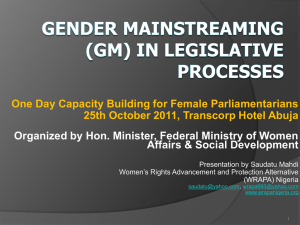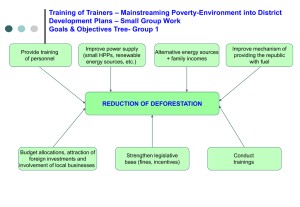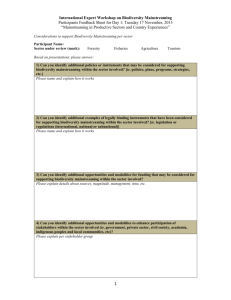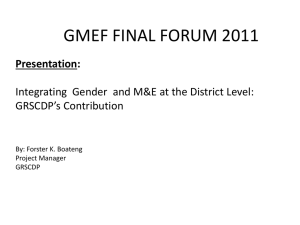Country-led environmental and climate change
advertisement
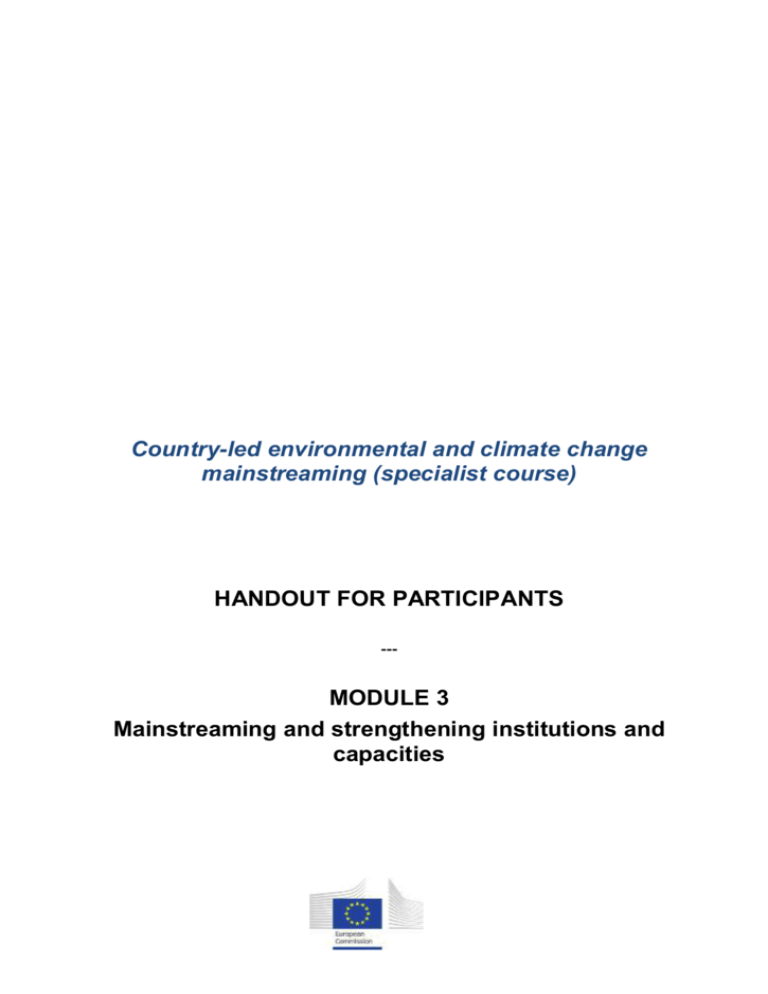
Country-led environmental and climate change mainstreaming (specialist course) HANDOUT FOR PARTICIPANTS --- MODULE 3 Mainstreaming and strengthening institutions and capacities MODULE 3 – Mainstreaming and strengthening institutions and capacities TOPICS COVERED BY THE MODULE: - What is mainstreaming, and why mainstream environment and climate change? A framework for mainstreaming environment and climate change. Strengthening institutions and capacities. Principles for institutionalising environment and climate change mainstreaming. Tools and actions for supporting institutional and capacity strengthening. KEY APPROACHES, TOOLS AND ACTIVITIES: - UNDP-UNEP Poverty-Environment Initiative framework for mainstreaming. National capacity self-assessment. Stakeholder analysis. Setting up of working mechanisms. Activities supporting learning-by-doing (e.g. formal training, exchange visits, on-the-job learning, lesson learning and dissemination). KEY CONCEPTS AND MESSAGES: What is mainstreaming, and why mainstream climate change? 1. Environment and protection of natural resources is a sector of development in its own right. However, the performance of other sectors closely depends on the state of the environment and natural resources (notably agriculture, water, health, forestry, fisheries, tourism), and sector development can have adverse impacts on the environment (especially manufacturing, infrastructure, energy, transport). Thus it does not suffice to address the environment exclusively as a sector; other sectoral development paths rely on the environment, and despite these linkages the environment tends to be an underfunded sector or area. 2. There is a strong case for environmental mainstreaming into other sectors, in addition to maintaining environment as a sector in its own right. As expressed by the Global Environment Facility (GEF): “The basic reason why environmental mainstreaming is important is that economic and social development and the environment are fundamentally interdependent – the way we manage the economy and political and social institutions has critical impacts on the environment, while environmental quality and sustainability, in turn, are vital for the performance of the economy and social well-being. As such, the task of environmental integration and mainstreaming is at the forefront of development planning and policy formulation” (GEF). 3. Climate change adaptation and mitigation often start with project-based approaches. National Adaptation Programmes of Actions (NAPAs) are an example of project-based approach. They can be a first step in the right direction: they were useful in raising awareness of climate change; they triggered a process of national consultation and cross-sectoral cooperation – thus contributing to national capacity building; good NAPAs took account of existing coping strategies, and their formulation involved stakeholders at the grassroots level; and the priority projects they identified usually correspond to real priorities and involve wider developmental benefits (World Bank 2010a). Module 3: Mainstreaming and strengthening institutions and capacities 1 4. However, project-based approaches also have limitations. For instance, problems associated with NAPAs include low capacity for adaptation planning and implementation, and poor institutional arrangements for implementation. For successful implementation, coordinated involvement of various ministries, and coordination between the national and sub-national levels, are required but the necessary coordination mechanisms are often lacking (World Bank 2010a). Furthermore, there is a risk that NAPAs and other project-based instruments are developed in parallel with, and insufficiently integrated in, national development and poverty reduction strategies (Fankhauser & Schmidt-Traub 2010). 5. Standalone responses to climate change may also distort the development process by failing to allocate resources where they are likely to be most useful (e.g. due to an excessive focus on ‘structural’ responses i.e. infrastructure building) – or even by inadvertently promoting maladaptation (Burton & van Aalst 2004). In the medium and long term, they are unlikely to meet all adaptation and mitigation requirements in a cost-effective and scalable manner. More strategic, systematic and comprehensive approaches are required. 6. There is thus a strong case for mainstreaming climate change into all dimensions of development planning, both at national and sector levels and in local development (World Bank n.d. Guidance Note #4, Burton & van Aaalst 2004, Klein et al 2005, OECD 2009a, Fankhauser & Schmidt-Traub 2010). Adaptation and mitigation projects and measures will not disappear but are likely to be more effective and efficient if ‘nested’ within wider strategies and programmes and decided in the framework of wider development policies (Burton & van Aalst 2004, Fankhauser & SchmidtTraub 2010). As there is limited scope for identifying policies and measures that address climate change only, even standalone national adaptation policies and strategies may not be justified (Burton & van Aalst 2004) – unless they focus on climate change–development linkages and pave the way for mainstreaming. 7. Mainstreaming is the informed integration of a relevant value, theme or concern into the decisions of institutions that drive national, local and sector development policy, rules, plans, investment and action (adapted from Dalal-Clayton & Bass 2009). It can be seen as a long-term, iterative process aimed at transforming ideas and, even more importantly, transforming policies and practices – for the purpose of promoting desired developmental outcomes and supporting the identification and implementation of integrated solutions to human problems. Various themes can be mainstreamed in development policies including environment, climate change adaptation and mitigation, gender, governance, human rights, ... 8. Environment mainstreaming is ‘the informed inclusion of relevant environmental concerns into the decisions of institutions that drive national, local and sectoral development policy, rules, plans, investment and action’ (Dalal-Clayton and Bass, 2009). The UNDP-UNEP Poverty Environment Initiative work with the concept of ‘poverty-environment mainstreaming’, highlighting the poverty dimension, and propose the following definition: ‘The iterative process of integrating poverty-environment linkages into policymaking, budgeting and implementation processes at national, sector and subnational levels. It is a multi-year, multi-stakeholder effort that entails working with government actors (head of state’s office, environment, finance and planning bodies, sector and sub-national bodies, political parties and parliament, national statistics office and judicial system), non-governmental actors (civil society, academia, business and industry, general public and communities, and the media) and development actors’ (UNDP-UNEP, 2009). 9. Climate change mainstreaming ‘involves the integration of policies and measures to address climate change into ongoing sector and development planning and decision-making, so as to ensure the long-term sustainability of investments as well as (...) reduce the sensitivity of development activities to both today’s and tomorrow’s climate’ (Klein et al 2005: 584). Climate policies and strategies should promote the integration of adaptation and mitigation into Module 3: Mainstreaming and strengthening institutions and capacities 2 development policies, looking for synergies between adaptive and mitigation capacity, on the one hand, and development, on the other hand (Klein et al 2005). These synergies can be substantial, reducing transaction costs and promoting effectiveness, scalability and sound macroeconomic management (Fankhauser & Schmidt-Traub 2010). More specifically, the mainstreaming of climate change adaptation is defined as ‘the iterative process of integrating considerations of climate change adaptation into policy-making, budgeting, implementation and monitoring processes at national, sector and sub-national levels. It is a multi‐year, multi‐stakeholder effort grounded in the contribution of climate change adaptation to human well-being, pro-poor economic growth, and achievement of the MDGs1. It entails working with a range of government and non‐governmental actors, and other actors in the development field’ (UNDP-UNEP 2011: 3). 10. To sum up, the rationale for mainstreaming environment and climate change in the planning and implementation of development policies and interventions rests on various arguments: - The economy and society are intimately dependent upon the state of the environment; this is especially true of developing countries. Such links often create vicious cycles, where a situation of poverty leads to degradation of natural resources to obtain immediate and short-term benefits, but which in turn helps perpetuate poverty. The challenge is thus to turn such situations into virtuous circles where environmental sustainability contributes effectively to long-term economic development and human well-being. - Although often not quantified, degradation of the environment represents costs for the economy, be it directly reflected in reduced production and/or loss of revenue (e.g. low crop yields due to degraded soils), or indirectly (e.g. loss of genetic resource base on which future products may be developed). On the other hand the environment represents opportunities, in particular in terms of a green economy, green jobs and sustainable livelihoods. Environmental mainstreaming contributes to transitioning towards an inclusive and green economy. - Developing countries face the largest risks and impacts from climate change, while being more vulnerable than more developed countries (Stern 2007, OECD 2009a, World Bank 2010a). Climate change is thus a potentially significant threat to ongoing development and poverty reduction efforts. Mainstreaming climate change adaptation can make their development and societies more resilient to the impacts of climate change, and to current climate variability and extremes which are of immediate concern and relevance (Burton & van Aalst 2004). Mainstreaming climate change adaptation can also bring synergies between development and adaption and significant developmental benefits (see concept of ‘co-benefits’ in Module 2). - Climate change impacts are complex (due to complex interactions between biophysical and socio-economic effects) and tend to have implications at the level of whole sectors and across multiple sectors. Coordination is needed across sectors and levels of government, to ensure effective responses and efficient resource allocation. Climate change mainstreaming at the national, sector and local levels supports this. - Delaying the response to climate change is likely to be more costly than starting to act now. Failure to integrate vulnerability and adaptation considerations in national and local development strategies, budgets, programmes and projects may indeed result in wasted investment and/or increased future vulnerability, while failure to take action on mitigation is likely to result in much more severe climate change and therefore greater damage and much higher adaptation costs in future (Stern 2007, de Bruin et al 2009, OECD 2009b, World Bank 2010a). A framework for mainstreaming environment and climate change 11. Mainstreaming takes place at the various stages of the policy cycle, as shown in Figure 2.1. 1 Millennium Development Goals. Module 3: Mainstreaming and strengthening institutions and capacities 3 Figure 2.1 – Entry points for mainstreaming in national development planning Adapted from: UNDP-UNEP (2009) Mainstreaming Poverty-Environment Linkages into Development Planning: A Handbook for Practitioners. Figure 3.2, p. 15. 12. The ‘mainstreaming framework’ presented in Figure 2.2 has been adapted from the ‘programmatic approach to poverty-environment mainstreaming’ and framework for mainstreaming climate change adaptation developed by UNDP-UNEP (2009, 2011). This framework proposes a number of activities or steps for climate change mainstreaming. It is used as a guiding thread throughout the workshop. Annexes 2.1 and 2.2 provide progress checklists for environment and climate change mainstreaming respectively, structured along the lines of the proposed framework. Module 3: Mainstreaming and strengthening institutions and capacities 4 Figure 2.2 – Framework for mainstreaming environment and climate change Adapted from: UNDP-UNEP (2009) Mainstreaming Poverty-Environment Linkages into Development Planning: A Handbook for Practitioners. Figure 3.1, p. 15. Strengthening institutions and capacities 13. Institutional strengthening and change and capacity building are at the heart of any mainstreaming effort (UNDP-UNEP 2009, 2011). 14. Institutions can be defined as the rules, norms, structures and other social arrangements that shape and regulate human behaviour and interactions, and notably support decision making. Institutions are thus not the same thing as ‘organisations’ (although in the common language this is often the meaning given to institutions). Institutions can be formal or informal. An institutional framework is a system made up of rules, laws, policies and institutions – in which various organisations interact with each other (North 1990). 15. Typical weaknesses of the institutional framework for environmental governance, also likely to affect the governance of climate change, include the following (UNDP 2011): - Lack of integration of strategies linked to multilateral environmental agreements (MEAs, in particular the UN conventions on climate change, desertification and biodiversity) with national priorities. - Fragmentation of laws, regulations, policies, strategies. - Fragmentation and inefficiency of institutional arrangements often characterised by ‘overlapping mandates and approval processes, regulatory gaps, weak authority and enforcement, and inefficiencies in administration’ (UNDP 2011: 37). Module 3: Mainstreaming and strengthening institutions and capacities 5 - Failure of existing strategies and programmes to target the ‘planning, economic and social agencies and strategies that generally drive the national development agenda’ (UNDP 2011: 37). - Insufficient resources allocated to environmental agencies, which also have a low level of influence on national policies. - Existence of significant ‘implementation gaps’. - Programmes focused on building national institutions, failing to address significant needs for local capacity building. 16. Effective mainstreaming of environment and climate change requires a ‘conducive’ institutional setup, which avoids or addresses the above weaknesses and may include the following aspects (Schipper et al 2008, Dalal-Clayton and Bass 2009, UNDP-UNEP 2009 & 2011, Fankhauser & Schmidt-Traub 2010): - Cross-sectoral and cross-level coordination and cooperation, including linkages between various planning processes. - At national level, the existence of powerful ‘champions’2 (e.g. office of the prime minister, ministries of finance/budget/planning, ...) also responsible for the achievement of development outcomes, the allocation of resources and macroeconomic management. - Existence of mechanisms that support the integration of new thinking, new research results etc. within mainstream planning and monitoring systems and processes. - Existence of mechanisms that support learning, experience sharing and dissemination of good practices. - Existence of mechanisms that support timely stakeholder participation at various scales and decision-making levels. - To ensure meaningful stakeholder participation, the strengthening of capacities of stakeholders (including non-state ones) at various scales and levels. 17. Stakeholders are, generally speaking, those who have an interest in something; with regard to environment and climate change, they can be defined as individuals and groups whose livelihoods depends on natural resources, who are potentially affected by environmental degradation and/or the effects of climate change, and/or play a role in the selection, implementation and monitoring of environmental protection, adaptation and/or mitigation responses. Stakeholder analysis can be a useful tool for characterising stakeholders, i.e. formally identifying their objectives, interests, roles, capacities and capacity development needs (see further), influence, relationships, synergies and/or conflicts with other groups with regard to a specific issue such as environment or climate change (EC 2004). 18. Multiple stakeholders are or should be involved in the mainstreaming of environment and climate change – with each group having specific potential roles and responsibilities. Table 2.1 provides examples of the potential interests and roles of various stakeholder groups in relation to environment and climate change mainstreaming. ‘Champions’ are ‘respected, committed, influential individuals... who actively support and promote the cause of sustainable development’ (UNDP 2011: 42, quoting Binger et al 2002). 2 Module 3: Mainstreaming and strengthening institutions and capacities 6 Table 2.1 – Potential stakeholders in environment and climate change mainstreaming Stakeholders Interests and roles Central ministries such as the ministry of finance, ministry of budget, ministry of planning Office of the prime minister or office of the president - Sector ministries and agencies Local governments Disaster prevention and risk reduction community Parliament - National statistics office Scientific and academic organisations Investment promotion agencies Private sector (business and industry) - - Poverty reduction agencies, including development NGOs - Environmental organisations, including NGOs Media - Lead the mainstreaming effort, act as champions Define national policies and strategies Determine national standards and regulations Collect revenues, allocate resources across sectors, use instruments of economic policy Provide overall guidance and support for capacity building Define and implement sector policies, plans and programmes in the context of national policies and priorities Determine sector-specific standards and regulations Allocate resources within sectors Cooperate with each other in the context of cross-sectoral initiatives Support capacity building and institutional strengthening at sector level Implement national and sector policies and strategies at the local level Integrate these with local priorities in the context of local development and community strategies Support capacity building and institutional strengthening at the local level Address climate-related risks and climate change impacts as part of risk prevention and management activities Support capacity building and institutional strengthening Use legislative and advocacy roles to promote the adoption of ‘environmentally-integrated’ and ‘climate-compatible’ policies and legislation Use role in approving and monitoring the budget to promote environmental and climate change integration in the budgetary process Develop environmental and climate-related indicators and integrate them in performance assessment frameworks and the national monitoring system, in collaboration with policy makers and implementing agencies Build capacity to collect, manage and analyse data Provide policy-oriented research and expertise to support decision making Set up interdisciplinary teams to address climate-related challenges Contribute to building national capacities Support the ‘climate-proofing’ of investments Promote the bridging of development gaps Promote environmentally sustainable investments and economic activities Contribute to awareness raising Contribute through investments in clean technology and implementation of environmental management systems Design productive processes taking into account their environmental impacts Investigate potential impacts of CC, prepare for climate-related losses and opportunities and manage climate-related risks Contribute to sustainable investment in adaptation and mitigation Contribute to vulnerability reduction through fostering development Mitigate the impact of economic activities on the climate (e.g. through energy and resource efficiency) Address environmental impacts and climate change risks and impacts in their activities Finance and implement development programmes and projects that address environmental issues, reduce vulnerability and enhance adaptive capacity Use advocacy and monitoring roles in support of mainstreaming Support capacity building and institutional strengthening Use advocacy and monitoring roles in support of environment and climate change mainstreaming Provide expertise and support capacity building Contribute to awareness raising among decision makers, the general public, the communities they serve Promote public debate and public involvement in national/local planning Module 3: Mainstreaming and strengthening institutions and capacities 7 Stakeholders Interests and roles - Use monitoring role to foster transparency and accountability Bilateral and multilateral donors Local communities, farmers, general public - Support capacity development for environmental protection and climate change adaptation and mitigation, in line with national priorities - Support adaptation and mitigation projects - Support environment and climate change mainstreaming efforts - Adequately manage natural and other local resources, including to decrease local vulnerability to climatic risks - Make use of and share local knowledge to cope with environmental challenges and climate-related risks - Strive to preserve and enhance adaptive capacity Source: GCCA Support Facility, based on Conde & Lonsdale (2004), Ebi et al (2004), Schipper et al (2008), UNDPUNEP (2009) 19. Stakeholder capacity strengthening is a key aspect of institutional strengthening in the context of a mainstreaming strategy (see further). Principles for institutionalising environment and climate change mainstreaming 20. So what is the ‘ideal’ institutional setup for effective mainstreaming of environment and climate change? In fact, there is no single, ‘blueprint’ institutional model. Each country has to determine the most suitable institutional arrangements based on its current institutional structures, a clear diagnosis of their strengths and weaknesses, and a clear plan for overall governance improvement. However, there are some agreed principles and examples of good practice. 21. Here are a few principles for successful institutional and capacity strengthening in relation to the mainstreaming (UNDP-UNEP 2011): - Move the coordination of mainstreaming (and/or climate adaptation/mitigation) to a central body with a coordination mandate and decision-making power over line ministries, in particular with regard to budget allocation. For example, in China responsibility for coordination of climate-related issues lies with the powerful National Development and Reform Commission; in Kenya responsibility for managing the ‘Adaptation to Climate Change in Arid and Semi‐Arid Lands’ projects lies with the Office of the President; in Sierra Leone environmental mainstreaming is housed in the Environmental Protection Agency, which was strategically placed under the Office of the President. - Establish or strengthen coordination mechanisms, with a clear allocation of responsibilities and permanent arrangements (e.g. Mexico: the Inter‐Ministerial Commission on Climate Change, which includes seven ministries of which the Ministry of Finance, has a clear mandate with regard to the mainstreaming of adaptation- and mitigation-related aspects; it is organised on the basis of dedicated working groups focused on specific aspects/topics). - Wherever possible, build on pre-existing intersectoral coordination mechanisms, such as coordination structures for food security, disaster risk reduction, sustainable land management, or environmental management. In many instances, this will be more likely to succeed than building up new structures and mechanisms from scratch. - Institutionalise flexibility, for instance in the form of a commitment to regular policy/strategy revisions and reassessment of available knowledge. - Institutionalise mainstreaming, for instance in the guidelines, procedures and systems related to the preparation and adoption of development policies in the criteria for screening and prioritising programmes and projects, or through legal requirements for Strategic Environmental Assessment and Environmental Impact Assessment). Module 3: Mainstreaming and strengthening institutions and capacities 8 - Develop effective national–local coordination mechanisms, identifying the most suitable level at which to cooperate/coordinate (e.g. in Rwanda, annual performance contracts are signed between various levels of government – central government–provinces, provinces–districts, districts–sectors, sectors–villages, ... – with a clear definition of goals, indicators of achievement and activities for achieving objectives; this mechanism supports both coordination across levels of government and accountability). - Strengthen institutions at the sub-national level, taking care not only of transferring skills and providing adequate technical support, but also of matching the transfer of competences to decentralised levels of government with a transfer of resources. Tools and actions for supporting institutional and capacity strengthening 22. Annex 2.3 provides a list of guiding questions for assessing institutional and capacity development needs in government. 23. Key steps in institutional and capacity strengthening for mainstreaming are: - needs assessment – undertaken in a context of continuous stakeholder engagement for capacity development, and to be followed by the formulation, implementation and evaluation of a capacity development plan (UNDP 2011); - the setting up of working mechanisms for mainstreaming; - learning-by-doing; - to ultimately reach the point where mainstreaming becomes a standard practice (UNDP-UNEP 2011). This process should be iterative: periodic needs assessments and reviews of working mechanisms, and continuous learning-by-doing, can help deepen and improve the mainstreaming process. An evaluation of capacity development results should be implemented regularly. Capacity development works best if undertaken with a medium- to long-term time horizon, allowing for relationship building, experimentation, and the development of locally appropriate solutions (UNDP 2011). 24. Capacity development should take place at three complementary levels: - the ‘enabling environment’ or ‘system level’, which encompasses ‘the political, economic, policy, social, legal and regulatory systems within which organisations and individuals operate’; - the organisation level, including ‘government institutions and civil society, community and private sector organisations’; - and the individual level (UNDP 2011: 13-14). 25. A key aspect to consider is that ‘capacity development can only be defined in relation to a specific goal – it does not exist for its own sake’ (UNDP 2011: 26). The starting point of any capacity development effort should thus be to answer the question ‘Capacity for what?’ This is essential for identifying priority needs and then measuring results. 26. Capacity development should target two types of capacities: - functional capacities, i.e. the generic capacities ‘needed to undertake the core functions involved in designing, implementing and evaluating [environment and/or climate change mainstreaming] initiatives’ (UNDP 2011: 16) – e.g. information systems and analytical skills; planning and prioritisation skills; participatory engagement and empowerment skills; political and communication skills; monitoring, evaluation and learning skills (Dalal-Clayton & Bass 2009); Module 3: Mainstreaming and strengthening institutions and capacities 9 - and technical capacities, i.e. the specialised capacities ‘needed to carry out functions and activities related to specific aspects of [environmental or climate change risk] management and (...) mainstreaming’ (UNDP 2011: 16) – e.g. capacity to assess, reduce and manage climaterelated risks; to use economic instruments to support adaptation and mitigation; to value the natural capital or to mainstream environment and climate change in a range of sector strategies; while considering four crosscutting issues that are strongly related to capacity development: - institutional arrangements; accountability mechanisms; leadership; and the management of knowledge and information (UNDP 2011: 18-19). 27. Table 2.2 illustrates some of the possible objectives and outcomes of a capacity development programme in support of environment and climate change mainstreaming. Table 2.2 – Possible objectives and outcomes of capacity development LEVEL OF CAPACITY EXAMPLES OF CAPACITY DEVELOPMENT OBJECTIVES/OUTCOMES DEVELOPMENT ‘Enabling environment’ or institutional level Improved political commitment to environment and/or climate change mainstreaming. Improved policy, legal and regulatory frameworks in support of environment and/or climate change adaptation and mitigation. Actual integration of environment and/or climate-related considerations in national and sector policies, strategies and programmes. Improved inter-agency coordination and collaboration frameworks on environment- and climate-related issues. More resources allocated to environmental, and adaptation & mitigation measures in the national budget. Institutional and organisational levels Upgraded knowledge and information systems, allowing to track environmental and/or climate trends, and the response to environmentand/or climate-related challenges, including policy and institutional change, and the actual implementation and outcomes of environment- and/or climate-related measures in policies, strategies, programmes and projects. Organisational level Defined organisational mandates, structures and functions for mainstreaming. Strengthened management, planning and operational frameworks for mainstreaming. Strengthened administrative and budgetary systems and procedures for mainstreaming. Strengthened personnel management and human resources development in relation to the management of environment- and/or climate-related issues. Individual level Increased awareness of environment-development links and climate change and its implications, including changed attitudes, beliefs, values, motivation and commitment. Expanded knowledge and understanding of priority topic areas. Improved skills and changed behaviours with regard to environment and/or climate change mainstreaming, including technical, scientific, planning, research, information management/ICT, interdisciplinary, communication and collaboration skills and actions. Module 3: Mainstreaming and strengthening institutions and capacities 10 Adapted from: UNDP (2011) Practitioner’s Guide: Capacity Development for Environmental Sustainability. United Nations Development Programme, New York. Annex A – Tool #3: Possible capacity development responses, pp. 63-71. 28. National capacity self-assessments (NCSAs) (also known as ‘capacity and needs assessments’) are a useful tool for supporting the initial step of institutional and capacity strengthening. The concept was initially developed in the context of Global Environment Facility (GEF) activities to promote capacity development for the implementation of the ‘Rio conventions’ (UN conventions on climate change, desertification and biodiversity). An NCSA is ‘a country-driven, locally adapted, consultative process that aims to: (i) review global environment issues that require priority attention; (ii) determine how capacity development could strengthen management of these issues; and (iii) prepare a national action plan for capacity development for global environmental management’ (UNDP 2011: 72). 29. For the purpose of environment and climate change mainstreaming, the results of existing assessments (if any) can be used3, and/or ad hoc assessments can be undertaken as necessary. They can be conducted at various levels, including the national, individual organisation and local levels (World Bank n.d. Guidance Note #4, UNDP-UNEP 2011). 30. At the organisation level in particular, for all organisations expected to play a role in the mainstreaming of environment and climate change, NCSAs can consider: - the level of education of staff, and their awareness of environment-development linkages and climate variability and change; - mandates and functions with regard to environment and climate-related issues; - the influence of climate risks and the state of the environment on capacity to function; - the technical, financial, legal/regulatory capacities with regard to environment- and climaterelated issues; - environmental and climate information systems; - planning, decision-making, budget allocation and programming mechanisms; - collaboration and coordination structures and mechanisms; - and communication capacities (adapted from UNDP-UNEP 2011). 31. NCSAs should identify and focus on a limited, realistic number of ‘priority capacities’, using prioritisation techniques to ‘identify key limiting factors that would, if addressed, leverage significant improvements in capacity to address the most pressing (...) issues’ (UNDP 2011: 24). For each priority capacity, the assessment should identify ‘capacity assets’, i.e. strengths and opportunities on which to build capacity development efforts, and ‘capacity needs’, i.e. the gaps and weaknesses to be addressed. Current and desired levels of capacity should also be clearly identified (UNDP 2011). The output of the NCSA should be a ‘baseline report’ supporting the formulation of a capacity development plan with clearly defined objectives (expressed in terms of outputs, outcomes and impacts) for addressing identified weaknesses, and allowing the subsequent tracking of progress and achievements as a result of the mainstreaming process (World Bank n.d. Guidance Note# 4, UNDP 2011, UNDP-UNEP 2011). The UNDP’s NCSA website (http://www.undp.org/mainstreaming/ncsa.shtml) gives access to NCSA reports and action plans for over 120 countries. Capacity assessments undertaken in the context of country environmental studies, strategic environmental assessments, national adaptation programmes of action (NAPAs), programme and project documents and evaluation reports, etc. may also be good sources of information. 3 Module 3: Mainstreaming and strengthening institutions and capacities 11 32. Stakeholder analysis can usefully support capacity assessments and self-assessments: it can help determine who should be involved in capacity development, current capacities, capacity gaps, priority capacity development needs, and the most appropriate techniques for engaging various groups of stakeholders (UNDP 2011). 33. Another important aspect of institutional and capacity building, which can at least in part build on the results of an NCSA, is the setting up of working mechanisms for launching an environment and/or climate change mainstreaming initiative. This involves: - defining institutional arrangements, at political and technical levels (e.g. steering and technical committees); - setting up a management framework for mainstreaming, specifying leadership arrangements, allocation of human resources, financial arrangements, monitoring and evaluation arrangements; - developing an operational work plan (UNDP-UNEP 2009). Note that the initial working mechanisms set up at the time of launching a mainstreaming programme are unlikely to be the same as the final institutional framework that will be defined and gradually developed through the mainstreaming programme. 34. A wide range of complementary approaches exist to support institutional and capacity building with a focus on learning-by-doing – which, for optimal results, can be used in combination. These approaches include: - formal training – on environment and/or climate change mainstreaming and on multiple technical aspects linked to the response to climate change and environmental management; - exchange visits; - on-the-job learning, in particular in the context of national mainstreaming programmes; such learning can be promoted by work in interdisciplinary teams, twinning arrangements between organisations, well-managed technical support emphasising knowledge sharing and know-how transfers, and the implementation of demonstration projects; - lesson learning and the dissemination of knowledge and experience (UNDP-UNEP 2009). REFERENCES: Binger A. et al. (2002) Capacity 21: Evaluation Report, 1993-2001. United Nations Development Programme, New York. Quoted by UNDP (2011) Practitioner’s Guide: Capacity Development for Environmental Sustainability. United Nations Development Programme, New York. Burton I. & van Aalst M. (2004) Look Before You Leap: A Risk Management Approach for Incorporating Climate Change Adaptation in World Bank Operations. Final draft. World Bank,Washington, DC. Available from: http://wwwwds.worldbank.org/external/default/WDSContentServer/WDSP/IB/2004/10/06/000160016_20041006 165241/Rendered/PDF/300650PAPER0Look0Before0You0Leap.pdf. Conde C. & Lonsdale K. (2004) Engaging Stakeholders in the Adaptation Process. In: Lim B. & SpangerSiegfried E. (eds.) (2004) Adaptation Policy Frameworks for Climate Change: Developing Strategies, Policies and Measures. United Nations Development Programme/Cambridge University Press, New York. Available from: http://www.undp.org/climatechange/adapt/apf.html. Module 3: Mainstreaming and strengthening institutions and capacities 12 Dalal-Clayton B. & Bass S. (2009) The challenges of environmental mainstreaming: experience of integrating environment into development institutions and decisions. International Institute for Environment and Development, London. Available from: http://www.environmental-mainstreaming.org/key-lit.html. de Bruin K., Dellink R. & Agrawala S. (2009) Economic Aspects of Adaptation to Climate Change: Integrated Assessment Modelling of Adaptation Costs and Benefits. OECD Environment Working Paper no. 6, OECD Publishing, Paris. Available from: http://www.oecd.org/env/workingpapers. Ebi K., Lim B. & Aguilar Y. (2004) Scoping and Designing an Adaptation Project. In: Lim B. & SpangerSiegfried E. (eds.) (2004) Adaptation Policy Frameworks for Climate Change: Developing Strategies, Policies and Measures. United Nations Development Programme/Cambridge University Press, New York. Available from: http://www.undp.org/climatechange/adapt/apf.html. EC (2004) Project Cycle Management Guidelines. Aid Delivery Methods series, Volume 1. European Commission, Brussels. Available from: http://ec.europa.eu/europeaid/infopoint/publications/europeaid/documents/49a_adm_pcm_guidelin es_2004_en.pdf. Fankhauser S. & Schmidt-Traub G. (2010) From adaptation to climate-resilient development: the costs of climate-proofing the Millennium Development Goals in Africa. Policy paper. Centre for Climate Change Economics and Policy, University of Leeds & London School of Economics and Political Science / Grantham Research Institute on Climate Change and the Environment, London School of Economics and Political Science. Available from: http://www.cccep.ac.uk/Publications/Policy/docs/PPFankhauseretal_costs-climate-proofing.pdf. Klein R., Schipper E. & Dessai S. (2005) Integrating mitigation and adaptation into climate and development policy: three research questions. Environmental Science and Policy, 8 (6) 579-588. doi:10.1016/j.envsci.2005.06.010. Available from: http://geography.exeter.ac.uk/staff/sddownloads/. North D. (1990) Institutions, Institutional Change and Economic Performance. Cambridge University Press, Cambridge. OECD (2009a) Integrating Climate Change Adaptation into Development Co-operation: Policy guidance. OECD Publishing, Paris. [Read-only, browse-it edition] Available from: http://browse.oecdbookshop.org/oecd/pdfs/browseit/4309171E.PDF. OECD (2009b) The Economics of Climate Change Mitigation: Policies and actions for global action beyond 2012. OECD Publishing, Paris. Schipper E.L., Paz Cigarán M. & McKenzie Hedger M. (2008) Adaptation to Climate Change: The new challenge for development in the developing world. Environment & Energy Group, United Nations Development Programme, New York. Available from: http://www.undp.org/climatechange/docs/English/UNDP_Adaptation_final.pdf. Stern N. (2007) The Economics of Climate Change: Stern Review. Cambridge University Press: Cambridge. Pre-publication edition also available from: http://webarchive.nationalarchives.gov.uk/20100407010852/http://www.hmtreasury.gov.uk/sternreview_index.htm. UNDP (2011) Practitioner’s Guide: Capacity Development for Environmental Sustainability. United Nations Development Programme, New York. Available from: http://www.undp.org/mainstreaming/cdes.shtml. Module 3: Mainstreaming and strengthening institutions and capacities 13 UNDP-UNEP (2009) Mainstreaming Poverty-Environment Linkages into Development Planning: A Handbook for Practitioners. UNDP-UNEP Poverty-Environment Initiative. Available from: http://www.unpei.org/PDF/PEI-full-handbook.pdf. UNDP-UNEP (2011) Mainstreaming Adaptation to Climate Change into Development Planning: A Guide for Practitioners. UNDP-UNEP Poverty-Environment Initiative. Available from: http://www.unpei.org/knowledge-resources/publications.html. World Bank (n.d.) Mainstreaming Adaptation to Climate Change in Agriculture and Natural Resources Management Projects. Guidance Note #4 – Developing Readiness for Institutional Capacity Development and an Enabling Policy Framework. World Bank, Washington, DC. [Online] Available from: http://climatechange.worldbank.org/climatechange/content/mainstreaming-adaptationclimate-change-agriculture-and-natural-resources-management-project. World Bank (2010a) Development and Climate Change. World Development Report 2010. World Bank, Washington, DC. Available from: http://go.worldbank.org/ZXULQ9SCC0. USEFUL WEBSITES: Adaptation Learning Mechanism – a global knowledge-sharing platform on climate change adaptation, allowing users to share reports, data, case studies, good practices, lessons learned, innovative approaches, tools and guidance: http://www.adaptationlearning.net/ UNDP – Integrating environment into development: http://www.undp.org/mainstreaming/ UNDP – Capacity development for environmental sustainability: http://www.undp.org/mainstreaming/cdes.shtml UNDP – National capacity self-assessment website, including an ‘NCSA resource kit’ and NCSA reports and action plans for over 120 countries: http://www.undp.org/mainstreaming/ncsa.shtml World Bank – Mainstreaming Adaptation to Climate Change in Agriculture and Natural Resources Management Projects: http://climatechange.worldbank.org/climatechange/content/mainstreaming-adaptation-climatechange-agriculture-and-natural-resources-management-project Module 3: Mainstreaming and strengthening institutions and capacities 14 Annex 2.1 – Progress checklist for environment mainstreaming Finding the entry points and making the case Entry points for environment mainstreaming agreed on and related road map taken into account in the workplan for the following stage of the effort Key ministries (e.g. environment, finance, planning, sectors) relevant to the agreed entry points are members of the steering committee or task force of the poverty-environment mainstreaming effort Environment mainstreaming champions liaising with in-country donor coordination mechanisms Activities to be implemented in collaboration with the finance and planning or relevant sector ministries included in the workplan for the following stage of the effort Mainstreaming environment into policy processes Country-specific evidence is collected on the contribution of the environment to human well-being and pro-poor economic growth Environment-development linkages included in the working documents produced during the targeted policy process (e.g. documents produced by the working groups of the PRSP or relevant sector and subnational planning processes) Environmental sustainability included as a priority in the completed policy documents of targeted policy process (e.g. PRSP, MDG strategy, relevant sector or sub-national plan) Policy measures to mainstream environment costed by finance and planning or sector ministries and subnational bodies Meeting the implementation challenge Environment indicators linked to policy documents of national development planning integrated in the national monitoring system Increased budget allocations for environmental mainstreaming policy measures of nonenvironment ministries and subnational bodies Increased public expenditures for environmental mainstreaming policy measures of nonenvironment ministries and subnational bodies Increased in-country donor contributions for environment issues Environment mainstreaming established as standard practice in government and administrative processes, procedures and systems (e.g. budget call circulars, systematic public environmental expenditure reviews and other administrative procedures and systems) Long-term outcomes Institutions and capacities strengthened for long-term environment mainstreaming Conditions for simultaneous improvement in environmental sustainability and poverty reduction enhanced Adapted from: UNDP-UNEP (2009) Mainstreaming Poverty-Environment Linkages into Development Planning: A Handbook for Practitioners. Table 6.1, p. 88. Module 3: Mainstreaming and strengthening institutions and capacities 15 Annex 2.2 – Progress checklist for climate change mainstreaming Finding the entry points and making the case Climate–development–poverty linkages are identified. Available evidence (e.g. existing reports on current climate, trends and projections; risk, vulnerability and impact assessments; economic, social and environmental assessments; pilot adaptation and mitigation projects) is collected and used to raise awareness and mobilise stakeholders. Key governmental and non-governmental actors, including champions, are identified and mobilised at the national, sector and sub-national levels, to build a national consensus and commitment to climate-resilient, low-emission development. A communication and advocacy strategy is developed. National capacities for mainstreaming climate change are assessed, and capacity development needs of various stakeholders are identified. A management framework and institutional arrangements (e.g. task force or steering committee, technical working groups) are set up to support a climate change mainstreaming initiative. Entry points and priorities for adaptation and mitigation mainstreaming are identified, and a work plan for the next stage of the effort is formulated and approved. Mainstreaming climate change into policy and planning processes Country-specific evidence is collected on climate change impacts and possible adaptation and mitigation responses (e.g. from vulnerability and adaptation assessments, macro and meso economic analysis, demonstration projects, climate risk screening/assessment, and strategic environmental/climate assessment). Entry points are used to include adaptation and mitigation considerations in the national and sector policy and planning cycles. At the policy formulation stage, climate change and its links to development and poverty reduction are addressed in national and sector policies and strategies. At the planning stage, adaptation and mitigation programmes, projects and measures are integrated in multi-year national and sector development plans. Adaptation and mitigation options and measures are costed, assessed, prioritised (e.g. using costbenefit analysis, cost-effectiveness analysis, and multi-criteria analysis). Capacities are strengthened with a focus on ‘learning by doing’. Meeting the implementation challenge The implications of climate change and of related measures on the macroeconomic framework and government revenues and expenditures are considered. Adequate public resources are allocated for the implementation of priority adaptation and mitigation programmes, projects and measures – in particular those mainstreamed in programmes not specifically focused on climate issues. If appropriate, resources are reallocated to more vulnerable and/or priority sectors and regions. National development monitoring systems are enhanced to monitor climate variability and change, track progress in institutionalising climate change mainstreaming, track the actual implementation of adaptation and mitigation policies and measures, and monitor their outcomes and impacts. Milestones, indicators and targets related to climate change and the associated response are included in the performance assessment frameworks of climate change strategies and action plans, Module 3: Mainstreaming and strengthening institutions and capacities 16 and those of relevant national and sector development strategies and programmes, sub-national development plans and individual projects. Climate change mainstreaming is established as a standard practice in government and administrative processes, procedures and systems (e.g. intersectoral coordination mechanisms in place; systematic climate risk screening and proofing of public infrastructure; systematic inclusion of adaptation and mitigation considerations in the budgetary process and in monitoring systems). Adapted from: UNDP-UNEP (2011) Mainstreaming Adaptation to Climate Change into Development Planning: A Guide for Practitioners. Box 3.1, p. 16. Module 3: Mainstreaming and strengthening institutions and capacities 17 Annex 2.3 – Guiding questions for assessing institutional and capacity development needs in government Institutional development needs What government organisations are relevant to mainstreaming environment and/or climate change adaptation and mitigation? What are their mandates? What are the budget allocations of these organisations? Are there overlapping mandates? Are there any specific mandates that are missing? How do government organisations coordinate and make decisions on the issues of environmental protection, and adaptation and mitigation? Are there any coordination gaps? Do the mechanisms in place need to be strengthened? How? Have there been (recent) institutional changes? Are institutional changes necessary in the context of mainstreaming environment and/or climate change adaptation and mitigation? How can such changes be fostered? What are the planning and programming mechanisms in place? What are the operating procedures of the government organisations? Do some mechanisms and procedures need to be strengthened? How? Capacity development needs What issues relevant to environment and/or climate change mainstreaming could be addressed through capacity development? Which are the priority capacities (functional capacities, e.g. for resource mobilisation, monitoring – and technical capacities, e.g. sector-relevant expertise) to be developed to address these issues? For priority capacities, what is the current baseline (including ‘capacity assets’, i.e. strengths and opportunities on which to build capacity development efforts), what are the needs (gaps and weaknesses to be addressed) and what are the objectives to be achieved? What are the best ways of involving stakeholders in the capacity development effort, and of delivering capacity development? Adapted from: UNDP-UNEP (2011) Mainstreaming Adaptation to Climate Change into Development Planning: A Guide for Practitioners. Box 4.7, p. 28; and UNDP (2011) Practitioner’s Guide: Capacity Development for Environmental Sustainability. United Nations Development Programme, New York. Annex A – Tool #1: CDES planning and programming tool, pp. 48-53. Module 3: Mainstreaming and strengthening institutions and capacities 18

